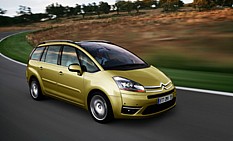Review
Citroen wants to forget about cashback deals and increase its fleet presence, from an overwhelming retail bias to almost 60% corporate sales share in the next few years.
And the firm believes the new C4 Picasso is the car to lead that charge. The seven-seat compact MPV is likely to confuse on spreadsheets and in auction halls, though, because the company has kept the Picasso name to sit alongside the smaller Xsara Picasso which remains on sale until 2009.
‘It’s our Verso’, justifies Citroën UK’s managing director Xavier Duchemin, ‘and we don’t want to lose such a well-known brand.’ Fair enough. Ignore the likely furrowed brows from confused buyers and the C4 looks like the Picasso brand in the ascendancy – this is a marked step up from the budget-priced and ageing Xsara Picasso, with two extra seats and prices (plus dimensions) in line with the recently revised Renault Grand Scenic.
It’s a striking looker, particularly at the front which features a panoramic windscreen. This floods the cabin with light and adds a feeling of well-being; thin A-pillars and large quarterlights are unusual for an MPV in offering plenty of vision at junctions.
As the Picasso is based on a stretched C4 platform this has enabled the company to make savings in development costs and have enabled it to fit the best-quality interior of any Citroën.
The cabin is the widest in the sector, and feels it, though the fold-flat rearmost seats are only for kids (and the boot is typically tiny when they’re in use). Space in the middle is OK but the chairs are set high and make occupants feel perched. A separate climate control system keeps them cool, though – such is the glass area that an optional secondary air-con unit is available for the rear.
There’s a wealth of other gadgets, too, like a parking sensor which measures spaces and says whether you’ll fit, digital instruments, standard cruise control and ESP, and even lights for the rear picnic trays and front door bins which sense and illuminate for approaching hands. Pneumatic rear suspension is also available as an option: its self-levelling function is a class-first.
Four engines will be offered, all familiar. Petrol power comes from either a 130bhp 1.8 or 145bhp 2.0-litre, with diesel offering either a 110bhp 1.6 or 140bhp 2.0-litre. Diesels will take two-thirds of sales and the 1.6-litre, producing 47.9mpg and 155g/km of CO2, will take the bulk of those. The 2.0-litre HDi isn’t far behind, offering 46.3mpg and 159g/km.
Controversially, Citroën will focus efforts on the EGS semi-automatic gearbox: indeed, the 2.0 HDi is only offered with it. Its steering column shifter and electric handbrake frees up space for a cool box in the dashboard.
The C4 Picasso is comfortable, refined and appealing. But it needs more than that to crack the fleet market. Good residuals, for one. Citroën is hoping for RVs in line with the Vauxhall Zafira, and marginally below the Volkswagen Touran, which puts in in the low to mid-30s.
Quite an aim, but it’s already been in discussions with CAP on how best to hone it prior to the January launch.
Keen prices, high equipment levels and the marginalisation of cashback deals will help, claims Citroën. We’ll see – Citroën has a history of launching cars promising less discounts but a few months later, that all changes.
But it is remaining cagey on numbers. The Xsara Picasso, in its heyday, sold around 30,000 annually and led the retail mini-MPV sector convincingly. Built on the same production line, Citroën can vary numbers of the C4 version to suit, but is hoping to do around 30,000 of both Picassos combined.
Seems conservative? You bet; maybe it’s proof of the education needed for buyers to spend between £15,000 and £20,000 on a Citroën without the lure of significant discounts.
| Model: | 1.8 | 2.0 | 1.6 HDi | 2.0 HDi EGS | ||||
| Max power (bhp/rpm): | 130/6,000 | 145/6,000 | 110/4,000 | 140/4,000 | ||||
| Max torque (lb-ft/rpm): | 125/3,750 | 148/6,000 | 177/1,750 | 200/2,000 | ||||
| Max speed (mph): | 115 | 121 (118) | 112 | 121 | ||||
| 0-62mph (secs): | 11.9 | 11.5 (12.2) | 12.7 (13.4) | 12.5 | ||||
| Fuel consumption (mpg): | 35.3 | 35.3 (31.7) | 47.9 (49.5) | 46.3 | ||||
| CO2 emissions (g/km): | 190 | 190 (211) | 155 (150) | 159 | ||||
| On sale: | January 2007 | Prices (est): | £15,000-£20,000 | |||||
Behind the wheel
In the French tradition, the C4 Picasso is softly suspended and, on smooth roads, gives a wonderfully fluent ride. Rougher surfaces make things more grumbly, and a bit more damping control would be nice, but it generally complements fine refinement and strong turbodiesel engines.
The 1.6-litre HDi is typically smooth and torquey, but is fractionally noisier than the quietest modern diesels on the market.
The 2.0-litre HDi felt rapid and easy-going, despite the EGS semi-automatic gearbox confusing itself and thinking it was linked to a petrol unit, downshifting unnecessarily and holding revs.
I also drove the 2.0-litre petrol, which disappointed with its lack of torque. It also confused the EGS gearbox even more, but both could yield jolty shifts in auto mode. It’s much better to use the tactile manual paddles.
The very high-set seats proved firm, the steering and brakes irritatingly light and anaesthetised, but handling was enjoyable despite body lean angles.
Grip was ample and standard ESP is a commendable addition. But comfort is a strong point, a far more important strength considering the type of person who chooses one of these cars.
| The new C4 Picasso | ||||||
 |
 |
 |
||||
















